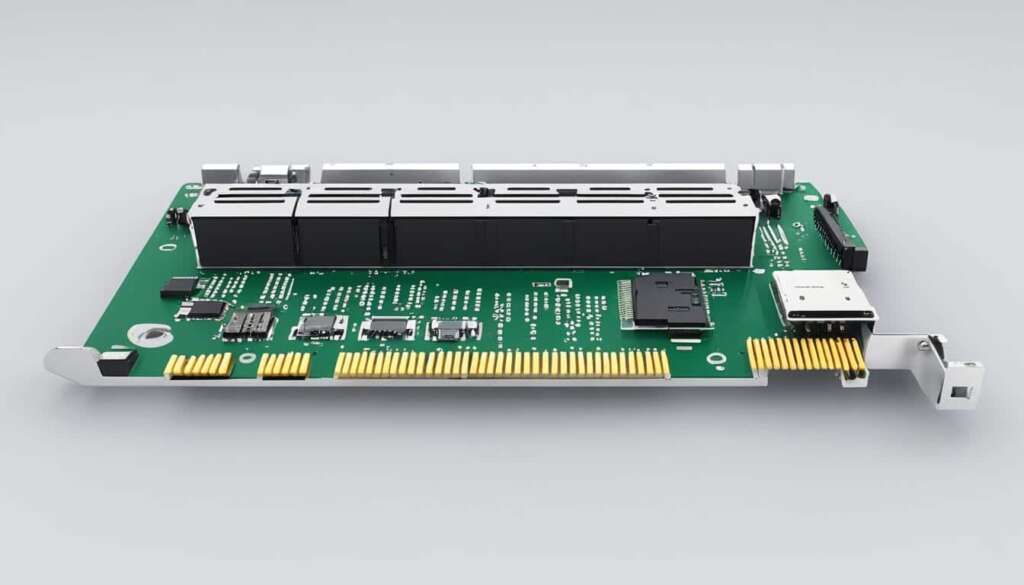Table of Contents
In today’s fast-paced technological world, data transfer is a crucial aspect of computer systems. SCSI, the Small Computer System Interface, is an interface technology that enables high-speed data transfer between various peripherals and a computer system. In this technology guide, we will provide a comprehensive understanding of SCSI, including its interface and technology. We will explore how SCSI is used in computer systems and how it enhances the efficiency of data transfer.
Key Takeaways
- SCSI is a high-speed interface technology that enables efficient data transfer between computer peripherals and a system.
- The origin of SCSI dates back to the early 1980s and has undergone several iterations since then.
- SCSI has several advantages over other interfaces, such as IDE or SATA, in terms of speed, scalability, and functionality.
- Understanding SCSI and its benefits can empower users to make informed decisions regarding their storage and device connectivity needs.
- Further exploration of SCSI’s applications and implementation options is possible with a solid foundation of its fundamentals.
What is SCSI?
The Small Computer System Interface, or SCSI, is a set of standards that defines how computers communicate with peripheral devices like hard drives, tape drives, printers and scanners, etc. The technology was first introduced in the early 1980s, and since then, it has undergone several iterations to keep pace with changing requirements.
SCSI is designed to provide fast data transfer rates, making it a preferred interface for applications that require high-speed data transfer and low latency. SCSI is used extensively by professionals in the media and entertainment industry, including video and audio production firms, and graphic designers.
One of the advantages of SCSI over other interfaces, such as IDE or SATA, is that it supports a wide range of devices and can be used with multiple operating systems, including Windows, macOS, and Linux. This versatility makes SCSI a popular choice for users who need compatibility with various devices.
Overall, SCSI is an interface technology that provides a reliable and efficient way to connect peripheral devices to computer systems.
SCSI vs. IDE vs. SATA
| Interface | Data Transfer Rate | Number of Devices | Supported OS |
|---|---|---|---|
| SCSI | Up to 640 MB/s | Up to 16 | Windows, macOS, Linux |
| IDE | Up to 133 MB/s | 2 | Windows, Linux |
| SATA | Up to 600 MB/s | 1 | Windows, macOS, Linux |
“SCSI has proven to be reliable and flexible over time, providing fast data transfer rates and compatibility with multiple devices and operating systems. It remains a robust interface technology well-suited for professional settings, where high-speed data transfer and compatibility are crucial.”
Conclusion
From this comprehensive guide, you now understand the significance of SCSI as an essential interface technology used in computer systems.
SCSI is a technology that provides faster and more efficient data transfer compared to other interfaces such as IDE or SATA. It is crucial for connecting different peripherals to computer systems, and its flexible nature makes it ideal for complex applications like servers and storage devices.
By grasping the fundamentals of SCSI, you can make informed decisions when choosing the best interface for your computer system. You can also appreciate the advantages of implementing SCSI technology to enhance the performance of your devices.
So, take the time to explore the various SCSI implementation options available to you. With SCSI, you can rest assured that your data transfer and device connectivity needs are met with speed and efficiency!
FAQ
What does SCSI stand for?
SCSI stands for Small Computer System Interface.
How does SCSI enhance data transfer efficiency?
SCSI improves data transfer efficiency by allowing for high-speed communication between a computer system and peripheral devices.
What are some advantages of SCSI over other interfaces?
SCSI offers greater flexibility, scalability, and the ability to connect multiple devices simultaneously compared to interfaces like IDE or SATA.
Which peripherals can be connected using SCSI?
SCSI can be used to connect various peripherals, including hard drives, tape drives, scanners, printers, and optical drives.
What are the origins of SCSI?
SCSI was first introduced in the 1980s as a standard interface for connecting peripherals to computer systems.
Can SCSI be used in modern computer systems?
Yes, SCSI is still widely used in professional environments and high-performance computing systems.
Are SCSI cables different from other interface cables?
Yes, SCSI cables have unique connectors and wiring configurations that allow for faster data transfer rates and longer cable lengths.
Is SCSI backward compatible with older devices?
SCSI devices and interfaces are often backward compatible, meaning newer SCSI devices can generally be used with older SCSI interfaces.
Are there different types of SCSI?
Yes, there are various SCSI standards, such as SCSI-1, SCSI-2, SCSI-3, and Ultra SCSI, each offering different data transfer speeds and features.
How can I determine if my computer system supports SCSI?
You can check the specifications of your computer system or consult the manufacturer’s documentation to see if SCSI support is included.













